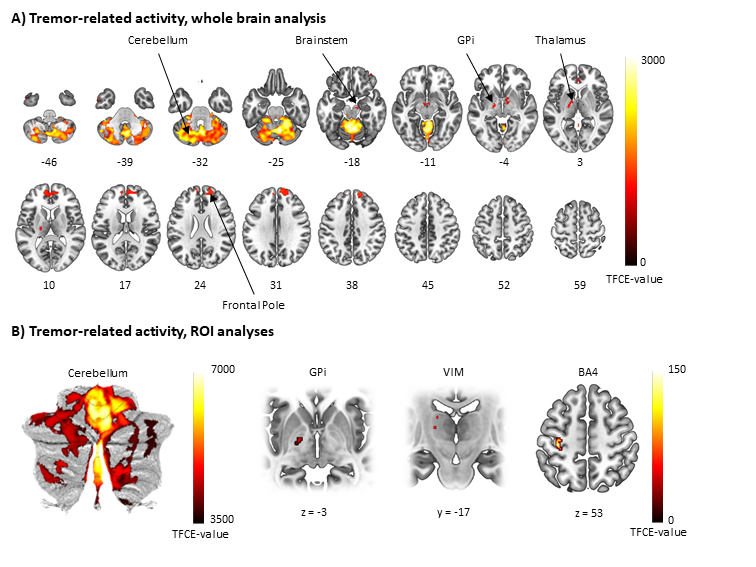Category: Tremor
Objective: To identify brain regions showing tremor-related activity in patients with dystonic tremor syndrome.
Background: Dystonic tremor syndromes are highly burdensome and treatment is often inadequate. This is partly due to poor understanding of the underlying pathophysiology. Several lines of research suggest involvement of the cerebello-thalamo-cortical circuit and the basal ganglia. However, studies directly linking tremor measurements to cerebral activity are lacking.
Method: In 27 patients with dystonic tremor syndrome, we used concurrent accelerometery and functional MRI during a posturing task that evoked tremor, alternated with rest. Using multiple regression analyses, we separated tremor-related activity from brain activity related to (voluntary) posturing. Additionally, we tested for altered functional connectivity between tremor-related brain regions in patients, and we compared grey matter volume between patients and matched controls (n=27).
Results: We found tremor-related activity in sensorimotor regions of the bilateral cerebellum, contralateral thalamus (ventral intermediate nucleus, VIM), contralateral primary motor cortex (hand area), contralateral pallidum, and the bilateral frontal cortex (laterality with respect to tremor) [figure1]. Grey matter volume was increased in patients compared to controls in the contralateral VIM, in which tremor-related activity was present, and in bilateral medial and left lateral primary motor cortex, in which no tremor-related activity was present. Connectivity analyses revealed reduced functional connectivity between cerebellum and the hand area of the contralateral primary sensorimotor cortex, specifically during tremor-evoking posturing. We found no evidence for differential involvement of cerebellum and pallidum depending on inter-individual differences in clinical tremor characteristics (jerkyness or dystonia severity).
Conclusion: These findings indicate that tremor in dystonia involves both the cerebellum and the basal ganglia. Deficient input from cerebellum towards the sensorimotor cortex, together with structural changes in the VIM, may play a key role in the generation of tremor in dystonia. Our findings suggest that tremor in dystonia involves not a single region or even a single network. Whether the degree of tremor-related activity in these regions can predict focal stereotactic treatment effects in individual patients remains to be investigated.
To cite this abstract in AMA style:
F. Nieuwhof, I. Toni, A. Buijink, A. van Rootselaar, C. Gallea, M. Vidailhet, B. Vande Warrenburg, R. Helmich. Tremor in dystonia is associated with increased brain activity in the cerebellum and pallidum [abstract]. Mov Disord. 2021; 36 (suppl 1). https://www.mdsabstracts.org/abstract/tremor-in-dystonia-is-associated-with-increased-brain-activity-in-the-cerebellum-and-pallidum/. Accessed January 7, 2026.« Back to MDS Virtual Congress 2021
MDS Abstracts - https://www.mdsabstracts.org/abstract/tremor-in-dystonia-is-associated-with-increased-brain-activity-in-the-cerebellum-and-pallidum/

